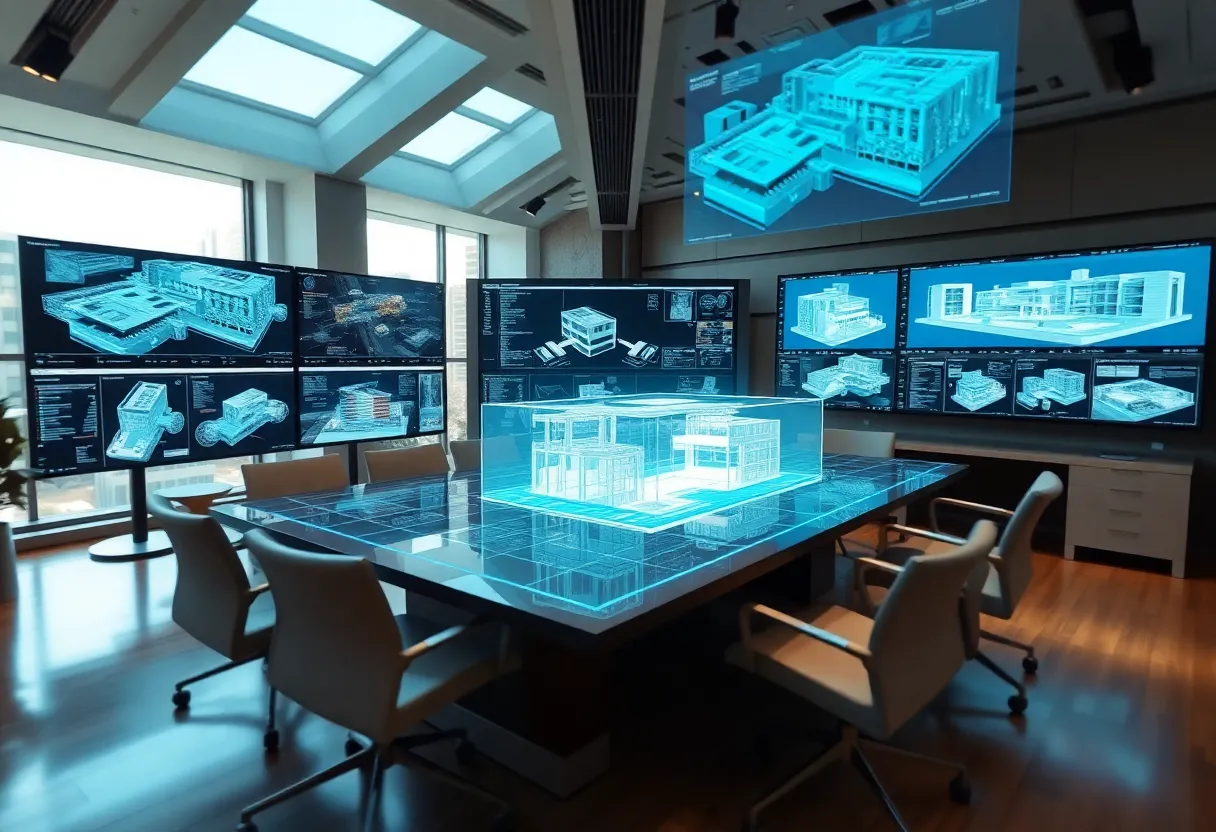Global, October 8, 2025
News Summary
The global construction design software market is valued at US$9.9 Billion and is projected to reach US$15.4 Billion, driven by rapid adoption of BIM, AI, cloud platforms and digital twin technologies. These tools enable 2D/3D modeling, structural analysis, clash detection and real-time collaboration, helping firms reduce risk, cut costs and accelerate delivery. Policy mandates for BIM, SaaS licensing models, and tighter integration with ERP, procurement and prefabrication ecosystems are broadening market reach. Rising venture funding into AI-driven AEC startups and growing in-house AI use are accelerating innovation, while AR/VR and automation boost stakeholder engagement, safety and productivity.
Construction design software market valued at US$9.9 Billion in 2024; forecast to reach US$15.4 Billion by 2030
The global market for Construction Design Software was estimated at US$9.9 Billion in 2024 and is on track to grow as design tools become central to project delivery. The market is projected to reach US$15.4 Billion by 2030, driven by a projected CAGR of 7.7% from 2024 to 2030. This growth reflects a widespread shift from conventional drawing tools toward platforms that combine BIM, AI, cloud collaboration and digital twin capabilities.
Why the market is expanding
The added report, titled Construction Design Software – Global Strategic Business Report, has been added to ResearchAndMarkets.com’s offering to track these changes and provide planning data for firms and investors. The software is now a cornerstone of modern architecture, engineering, and construction workflows because it enables core tasks such as 2D drafting, 3D modeling, Building Information Modeling (BIM), structural analysis and real-time collaboration.
Immediate benefits and use cases
Digital design tools streamline workflows, enhance project accuracy, and reduce the cost and time linked with manual revisions and on-site changes. Firms use design software to simulate construction sequencing, simulate energy performance, and perform clash detection so risks can be mitigated before physical work begins. These simulations boost decision-making and help teams avoid costly rework.
Technology trends shaping demand
Several technology trends are advancing the sector. Cloud-based platforms allow multiple stakeholders—architects, engineers, contractors and clients—to work simultaneously on a single project model from different locations, which is important for hybrid work and geographically distributed teams. AI integration supports generative design that suggests multiple design outcomes based on constraints and improves creativity and efficiency. Digital twin technology creates a real-time digital representation of a building or infrastructure asset; when incorporated into BIM platforms, it helps project managers monitor structural health, optimize maintenance and simulate performance using live data. Augmented reality and virtual reality tools enhance stakeholder engagement through immersive walkthroughs and planning reviews.
Regulation, markets and business models
Governments in regions such as North America, Europe, and Asia-Pacific are mandating BIM usage for public infrastructure planning, reinforcing software’s role in sustainability, cost transparency and lifecycle asset management. Demand is growing across both developed economies—where drivers include smart city development, retrofitting and green building initiatives—and emerging markets focused on urbanization, transport infrastructure and affordable housing.
The rise of modular and prefabricated construction is increasing demand for precision design software that supports off-site planning and factory-based fabrication. Integration of design tools with construction management software, ERP systems and procurement platforms is making end-to-end planning more efficient. Emergence of Software-as-a-Service models and modular licensing options is lowering entry barriers for small and mid-sized firms, while education and training centers are adopting these tools to prepare new professionals.
Venture activity and investment signals
Venture activity in the built environment is rising alongside software adoption. Of 159 AEC industry venture deals recorded in Q2, 110 deals (nearly 70%) involved startups identified as AI/ML-driven. Inflows increased by $1.7 billion, or 75.2%, from Q2 2024 to $3.96 billion. Of the $3.96 billion invested in built environment tech startups in Q2, $2.71 billion (roughly 68%) flowed into companies integrating AI/ML. These patterns show investors are prioritizing AI-enabled tools that can speed planning, reduce errors and support asset health management.
Adoption on the ground
Industry surveys show rising adoption of AI and design automation. More than a third of industry professionals report already using AI in their businesses (34%). Those using AI report saving an average of over three hours per week. Larger firms tend to adopt AI and advanced design tools faster, but SaaS pricing and training efforts are broadening access to smaller contractors and design shops.
Market focus and landscape
Software vendors are improving user experience with intuitive interfaces and automation to reduce learning curves. Strategic partnerships among software developers, construction tech firms and hardware providers—such as 3D scanners and drones—are forming ecosystems that bridge design and construction. The latest market reports include sections on market overview, trends and drivers, and profiles of leading players; one such construction design report features 34 companies.
Bottom line
Digital design platforms are evolving from optional tools into strategic necessities as urban growth accelerates. Growth drivers include the widespread shift to BIM, increasing integration of AI and generative design engines, adoption of cloud-based collaboration, and expansion of digital twin applications together with AR/VR. These technologies aim to improve visualization, reduce errors and make pre-construction decision-making more robust, supporting faster, greener and more resilient projects.
Frequently Asked Questions (FAQ)
Q1: What was the global market size for construction design software in 2024?
A1: The global market for Construction Design Software was estimated at US$9.9 Billion in 2024.
Q2: What is the forecasted market value by 2030?
A2: The market is projected to reach US$15.4 Billion by 2030.
Q3: What is the expected compound annual growth rate?
A3: The projected CAGR is 7.7% from 2024 to 2030.
Q4: Has the construction design software report been published or added to an offering?
A4: The report “Construction Design Software – Global Strategic Business Report” has been added to ResearchAndMarkets.com’s offering.
Q5: What venture activity was recorded in Q2 for the built environment?
A5: Of 159 AEC industry venture deals recorded in Q2, 110 deals (nearly 70%) involved startups identified as AI/ML-driven. Inflows increased by $1.7 billion, or 75.2%, from Q2 2024 to $3.96 billion. Of the $3.96 billion invested in built environment tech startups in Q2, $2.71 billion (roughly 68%) flowed into companies integrating AI/ML.
Q6: How many companies are featured in the construction design report?
A6: The report features 34 companies (some of the 34 companies are featured).
Q7: What are common software capabilities listed in the report?
A7: These software solutions enable 2D drafting, 3D modeling, Building Information Modeling (BIM), structural analysis, and real-time collaboration among stakeholders.
Q8: What adoption trend is reported among industry professionals regarding AI?
A8: More than a third of industry professionals report already using AI in their businesses (34%). Those using AI report saving an average of over three hours per week.
{
“@context”: “https://schema.org”,
“@type”: “FAQPage”,
“mainEntity”: [
{
“@type”: “Question”,
“name”: “What was the global market size for construction design software in 2024?”,
“acceptedAnswer”: {
“@type”: “Answer”,
“text”: “The global market for Construction Design Software was estimated at US$9.9 Billion in 2024.”
}
},
{
“@type”: “Question”,
“name”: “What is the forecasted market value by 2030?”,
“acceptedAnswer”: {
“@type”: “Answer”,
“text”: “The market is projected to reach US$15.4 Billion by 2030.”
}
},
{
“@type”: “Question”,
“name”: “What is the expected compound annual growth rate?”,
“acceptedAnswer”: {
“@type”: “Answer”,
“text”: “The projected CAGR is 7.7% from 2024 to 2030.”
}
},
{
“@type”: “Question”,
“name”: “Has the construction design software report been published or added to an offering?”,
“acceptedAnswer”: {
“@type”: “Answer”,
“text”: “The report “Construction Design Software – Global Strategic Business Report” has been added to ResearchAndMarkets.com’s offering.”
}
},
{
“@type”: “Question”,
“name”: “What venture activity was recorded in Q2 for the built environment?”,
“acceptedAnswer”: {
“@type”: “Answer”,
“text”: “Of 159 AEC industry venture deals recorded in Q2, 110 deals (nearly 70%) involved startups identified as AI/ML-driven. Inflows increased by $1.7 billion, or 75.2%, from Q2 2024 to $3.96 billion. Of the $3.96 billion invested in built environment tech startups in Q2, $2.71 billion (roughly 68%) flowed into companies integrating AI/ML.”
}
},
{
“@type”: “Question”,
“name”: “How many companies are featured in the construction design report?”,
“acceptedAnswer”: {
“@type”: “Answer”,
“text”: “The report features 34 companies (some of the 34 companies are featured).”
}
},
{
“@type”: “Question”,
“name”: “What are common software capabilities listed in the report?”,
“acceptedAnswer”: {
“@type”: “Answer”,
“text”: “These software solutions enable 2D drafting, 3D modeling, Building Information Modeling (BIM), structural analysis, and real-time collaboration among stakeholders.”
}
},
{
“@type”: “Question”,
“name”: “What adoption trend is reported among industry professionals regarding AI?”,
“acceptedAnswer”: {
“@type”: “Answer”,
“text”: “More than a third of industry professionals report already using AI in their businesses (34%). Those using AI report saving an average of over three hours per week.”
}
}
]
}
Key features at a glance
| Feature | Why it matters |
|---|---|
| 2D drafting | Basic documentation and plan production for permitting and construction. |
| 3D modeling | Visualizes geometry and spatial relationships before construction. |
| Building Information Modeling (BIM) | Centralizes data for lifecycle asset management, compliance and cost transparency. |
| Structural analysis | Validates loads and design safety early in the process to reduce rework. |
| Real-time collaboration (cloud) | Enables geographically distributed teams to work on one project model simultaneously. |
| Generative design (AI) | Suggests multiple solutions based on constraints to speed design and explore options. |
| Digital twin | Provides live monitoring and performance simulation for operations and maintenance. |
| AR/VR | Improves stakeholder engagement via immersive walkthroughs and spatial reviews. |
| SaaS and modular licensing | Lowers entry barriers for small and mid-sized firms and enables scalable adoption. |
| Integration with ERP and procurement | Supports end-to-end planning from design through procurement and construction. |
Deeper Dive: News & Info About This Topic
Additional Resources
- BDC Network: AI powers $3.96B venture boom in U.S. construction tech
- Wikipedia: Construction technology
- ResearchAndMarkets / Bizwire: Construction & Design Software Global Strategic Research Report 2025–2030
- Google Search: Construction design software market 2025 2030
- Construction Dive: Design-build smarter construction
- Google Scholar: Design-build construction efficiency
- Houzz / HomeNewsNow: 2025 State of AI in Construction and Design report
- Encyclopedia Britannica: AI in construction
- Precedence Research: Construction and Design Software Market
- Google News: construction design software market
Author: Construction CA News
The CALIFORNIA STAFF WRITER represents the experienced team at constructioncanews.com, your go-to source for actionable local news and information in California and beyond. Specializing in "news you can use," we cover essential topics like product reviews for personal and business needs, local business directories, politics, real estate trends, neighborhood insights, and state news affecting the area—with deep expertise drawn from years of dedicated reporting and strong community input, including local press releases and business updates. We deliver top reporting on high-value events such as the Rose Parade, Coachella, Comic-Con, and the California State Fair. Our coverage extends to key organizations like the California Building Industry Association and Associated General Contractors of California, plus leading businesses in technology and entertainment that power the local economy such as Apple and Alphabet. As part of the broader network, including constructionnynews.com, constructiontxnews.com, and constructionflnews.com, we provide comprehensive, credible insights into the dynamic landscape across multiple states.




